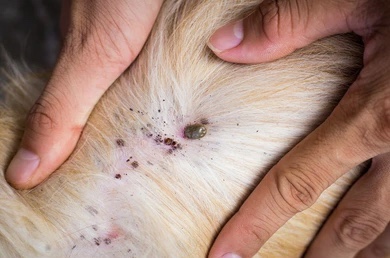
Ticks are small, parasitic insects that can transmit diseases to dogs, such as Lyme disease, Rocky Mountain spotted fever, and ehrlichiosis. It is important to remove ticks from your dog as soon as possible to prevent the spread of these diseases.
In this blog post, we will discuss the steps on how to safely remove ticks from dogs. We will also provide some tips on how to prevent ticks from biting your dog in the first place.
How to Remove Ticks from Dogs
Here are the steps on how to safely remove ticks from dogs:
- Gather your supplies. You will need a pair of fine-tipped tweezers, a tick removal tool, or a credit card. You may also want to have a small bowl of rubbing alcohol or soapy water to dip the tick in after removal.
- Locate the tick. Ticks are usually found in areas of your dog’s body with thick fur, such as the ears, neck, armpits, and groin. Use your fingers to part the fur and look for the tick.
- Grasp the tick as close to the skin as possible. Use the tweezers or tick removal tool to grasp the tick as close to the skin as possible. Be careful not to squeeze the tick, as this can cause the head to break off and remain in your dog’s skin.
- Pull the tick straight out. Apply gentle, steady pressure and pull the tick straight out. Do not twist or jerk the tick, as this can also cause the head to break off.
- Dispose of the tick. Once the tick is removed, you can either drop it into a small bowl of rubbing alcohol or soapy water or flush it down the toilet.
- Check for other ticks. Once you have removed one tick, it is important to check your dog for other ticks. Ticks can often travel in groups, so it is important to be thorough.
- Monitor your dog for signs of infection. After removing a tick, it is important to monitor your dog for signs of infection, such as redness, swelling, or discharge. If you notice any of these signs, contact your veterinarian.
Tips for Preventing Ticks on Dogs
Here are some tips for preventing ticks from biting your dog:
- Keep your dog’s fur trimmed short.
- Apply a tick repellent to your dog’s fur.
- Walk your dog in areas that are less likely to have ticks, such as paved areas or grassy areas that are well-maintained.
- Check your dog for ticks after every walk.
Conclusion:
By following these steps, you can safely and effectively remove ticks from your dog and prevent the spread of tick-borne diseases.
Frequently Asked Questions
Q: What are the signs of a tick bite?
A: The signs of a tick bite can vary depending on the type of tick and the severity of the bite. Some common signs include:
- Redness, swelling, or irritation at the bite site
- Fever
- Fatigue
- Loss of appetite
- Joint pain
- Swollen lymph nodes
Q: What are the risks of a tick bite?
A: Ticks can transmit a number of diseases to dogs, including:
- Lyme disease
- Rocky Mountain spotted fever
- Ehrlichiosis
- Anaplasmosis
- Babesiosis
These diseases can be serious, and some can even be fatal. It is important to take steps to prevent tick bites and to seek medical attention if your dog is bitten by a tick.
Q: What can I do to prevent ticks from biting my dog?
A: There are a number of things you can do to prevent ticks from biting your dog, including:
- Keep your dog’s fur trimmed short.
- Apply a tick repellent to your dog’s fur.
- Walk your dog in areas that are less likely to have ticks, such as paved areas or grassy areas that are well-maintained.
- Check your dog for ticks after every walk.
Q: What should I do if I find a tick on my dog?
A: If you find a tick on your dog, it is important to remove it as soon as possible. You can use a pair of fine-tipped tweezers, a tick removal tool, or a credit card to remove the tick. Be careful not to squeeze the tick, as this can cause the head to break off and remain in your dog’s skin.
Once you have removed the tick, you can dispose of it by dropping it into a small bowl of rubbing alcohol or soapy water, or by flushing it down the toilet.
Q: What should I do if my dog is showing signs of a tick-borne disease?
A: If your dog is showing signs of a tick-borne disease, such as fever, fatigue, or loss of appetite, it is important to take them to the veterinarian as soon as possible. The veterinarian will be able to diagnose the disease and recommend treatment.
I hope this FAQ section helps! Let me know if you have any other questions.
